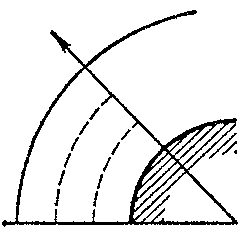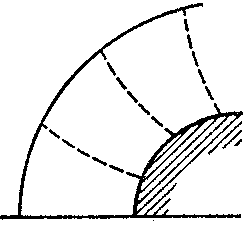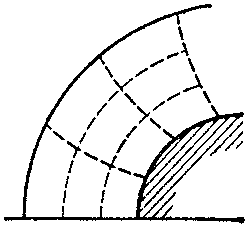Integral-relation method
strip method
A method for solving a system of partial differential equations, based on approximately reducing a partial differential equation to a system of ordinary differential equations. It is applicable to differential equations of various types. It was introduced by A.A. Dorodnitsyn [1] as a generalization of the method of straight lines, a generalization of it with the introduction of smoothened functions was given in [2], while in [3] the method was evaluated and further developed.
Suppose one has a system of partial differential equations in divergence form
 | (1) |
 |
where  ,
,  ,
,  are given functions in the independent variables
are given functions in the independent variables  ,
,  and in the unknown variables
and in the unknown variables  . Suppose further that a solution to (1) is sought for in the curvilinear rectangle with boundary
. Suppose further that a solution to (1) is sought for in the curvilinear rectangle with boundary  ,
,  ,
,  ,
,  , on which
, on which  conditions are posed, and where
conditions are posed, and where  of them are posed on
of them are posed on  and
and  . If the function
. If the function  is unknown in advance, one only needs one additional condition. If the boundary contains singular points, then instead of corresponding boundary conditions one uses regularity conditions.
is unknown in advance, one only needs one additional condition. If the boundary contains singular points, then instead of corresponding boundary conditions one uses regularity conditions.
In the  -th approximation the domain of integration is decomposed into
-th approximation the domain of integration is decomposed into  strips by the lines
strips by the lines  ,
,  . For each
. For each  one chooses a closed system of
one chooses a closed system of  linearly independent functions
linearly independent functions  . By multiplying each initial equation in (1) by
. By multiplying each initial equation in (1) by  and after integration, with respect to
and after integration, with respect to  , across all strips, one obtains
, across all strips, one obtains  integral relations of the form
integral relations of the form
 |
 |
 |
The integrals  ,
,  ,
,  are approximated by using interpolation formulas with respect to their values
are approximated by using interpolation formulas with respect to their values  ,
,  ,
,  on the boundaries of the strips. The integrals participating in the integral relations have the form
on the boundaries of the strips. The integrals participating in the integral relations have the form
 |
where  are numerical coefficients depending on the choice of the interpolation formulas and the form of the
are numerical coefficients depending on the choice of the interpolation formulas and the form of the  . The result is a system of ordinary differential equations, with respect to
. The result is a system of ordinary differential equations, with respect to  , relative to
, relative to  values of the unknown functions
values of the unknown functions  on the entire boundaries of the strips. This system is closed by
on the entire boundaries of the strips. This system is closed by  boundary conditions for
boundary conditions for  and
and  .
.
The functions  can be chosen rather arbitrarily. Choosing
can be chosen rather arbitrarily. Choosing  ,
,  , i.e. delta-functions, leads to the method of straight lines. In it the derivatives with respect to
, i.e. delta-functions, leads to the method of straight lines. In it the derivatives with respect to  are replaced by difference expressions, corresponding to the interpolation formulas chosen. When using the step-functions
are replaced by difference expressions, corresponding to the interpolation formulas chosen. When using the step-functions
 |
 , one simply speaks of the integral-relation method, and the initial equations are integrated across each strip. Moreover, the conservation laws chosen for (1) are written as the following integral relations for the strips:
, one simply speaks of the integral-relation method, and the initial equations are integrated across each strip. Moreover, the conservation laws chosen for (1) are written as the following integral relations for the strips:
 |
 |
For systems of quasi-linear hyperbolic-type equations one has investigated convergence and error of the integral-relation method [4]. In [4] one has also established results that indicate the superiority of the integral-relation method over that of straight lines. Later papers have investigated analogous results for elliptic-type equations.
The merits of the integral-relation method are, among others: the possibility of choosing the interpolation formulas and the function  in dependence on the behaviour of the solution; the exact integration with respect to one of the variables (a result of the divergence notation of the original equations); the simplicity of the computational algorithm; and the relatively-small amount of computer memory when calculating on a computer. In the integral-relation method one approximates by an integral: this increases the accuracy of the approximation on account of a reduction of the coefficient of the remainder term; the integral is a smoother function than the integrand, thus one may reduce the number of interpolation nodes. If the integrand has discontinuities of the first kind, then the integral is a continuous function. The integral-relation method is most efficient when the solution can be obtained with good accuracy for a small number of strips.
in dependence on the behaviour of the solution; the exact integration with respect to one of the variables (a result of the divergence notation of the original equations); the simplicity of the computational algorithm; and the relatively-small amount of computer memory when calculating on a computer. In the integral-relation method one approximates by an integral: this increases the accuracy of the approximation on account of a reduction of the coefficient of the remainder term; the integral is a smoother function than the integrand, thus one may reduce the number of interpolation nodes. If the integrand has discontinuities of the first kind, then the integral is a continuous function. The integral-relation method is most efficient when the solution can be obtained with good accuracy for a small number of strips.
The approximation in two variables of the integral-relation method can be generalized to the case of equations in three variables. Approximation in two variables can be conducted also in the two-dimensional case (the domain of integration is not partitioned into strips but into subdomains then); the system of approximate equations is then a system of non-linear algebraic or transcendental equations. Elements of the integral-relation method are used in other numerical methods, e.g. in the large-particle method.
The integral-relation method is mostly used in gas dynamics, where a number of practically-important problems have been solved by using it. Three schemes of the integral-relation method have been considered here: 1) the domain of integration is partitioned by lines passing through the surface of the body and the shock waves (Fig.a); 2) the domain of integration is partitioned by lines passing through the axis of symmetry and the boundary characteristics (Fig.b); and 3) the partitioning is into subdomains by two families of intersecting lines (Fig.c).

Figure: i051610a

Figure: i051610b

Figure: i051610c
The integral-relation method for computing supersonic flow around the fore part of a blunted body with propagating shock waves was developed in [5], in which a numerical solution to this problem in a direct formulation was obtained for the first time. The solutions for most general cases have been found (bodies of various forms; spatial flow; the flow of a real gas under equilibrium and non-equilibrium physical-chemical changes and radiations; non-stationary motion; and the flow of a viscous gas, [6]). The method has also been used for computing the potential flow of a gas [7], and for solving some mixed problems: flow in sub- and transonic parts of jets [8]. Pre-critical flow around a profile under an angle of attack with a place of the supersonic region has been considered [9]. Supersonic conic gas flow has been clarified by the integral-relation method.
The integral-relation method has found wide application in computing the flow of a viscous gas in the theory of boundary layers. In the laminar incompressible case a solution has been obtained up to the point of discontinuity [2]. Further, laminar boundary layers in a gas taking into account blowing-up or suction, radiation or heath conduction have been calculated. By the integral-relation method one has obtained solutions to the non-stationary problem of a point one-dimensional discontinuity in a gas taking counter-pressure into account, as well as in a gas with infinite conductivity in the presence of a magnetic field and in a heated gas.
References
| [1] | A.A. Dorodnitsyn, "On a method for numerically solving certain nonlinear problems of aerohydrodynamics" , Proc. third All-Union Math. Congress , 3 , Moscow (1956) pp. 447–453 (In Russian) |
| [2] | A.A. Dorodnitsyn, "On a method for solving the laminar boundary layer equation" Zh. Priklad. Mekh. i Tekhn. Fiz. , 1 : 3 (1960) pp. 111–118 (In Russian) |
| [3] | O.M. Belotserkovskii, P.I. Chushkin, "A numerical method of integral relations" USSR Comp. Math. Math. Phys. , 2 (1963) pp. 823–858 Zh. Vychisl. Mat. Mat. Fiz. , 2 : 5 (1962) pp. 731–759 |
| [4] | V.V. Bobkov, V.I. Krylov, "The method of integral relations for equations and systems of hyperbolic type" Differentsial'nye Uravneniya , 1 : 2 (1965) pp. 230–243 (In Russian) |
| [5] | O.M. Belotserkovskii, "Flow around a circular cylinder with a detached shockwave" Dokl. Akad. Nauk SSSR , 113 : 3 (1957) pp. 509–512 (In Russian) |
| [6] | O.M. Belotserkovskii, et al., "Flow of a supersonic gas around blunted bodies; theoretical and experimental investigations" , Moscow (1967) (In Russian) |
| [7] | P.I. Chuskin, "Subsonic gas flow around ellipses and ellipsoids" Vychisl. Mat. , 2 (1957) pp. 20–44 (In Russian) |
| [8] | Ya.I. Alikhashkin, A.P. Favorskii, P.I. Chushkin, "On the calculation of the flow in a plane laval nozzle" USSR Comp. Math. Math. Phys. , 3 : 6 (1963) pp. 1552–1558 Zh. Vychisl. Mat. Mat. Fiz. , 3 : 6 (1963) pp. 1130–1134 |
| [9] | T.C. Tai, "Transonic inviscid flow over lifting airfoils by the method of integral relations" J. AIAA , 12 (1974) pp. 798–804 |
| [10] | V.P. Korobeinikov, P.I. Chushkin, "Plane, cylindrical, and spherical explosions in a gas with counterpressure" Proc. Steklov Inst. Math. , 87 (1967) pp. 1–40 Trudy Mat. Inst. Steklov. , 87 (1966) pp. 4–34 |
Integral-relation method. Encyclopedia of Mathematics. URL: http://encyclopediaofmath.org/index.php?title=Integral-relation_method&oldid=47363